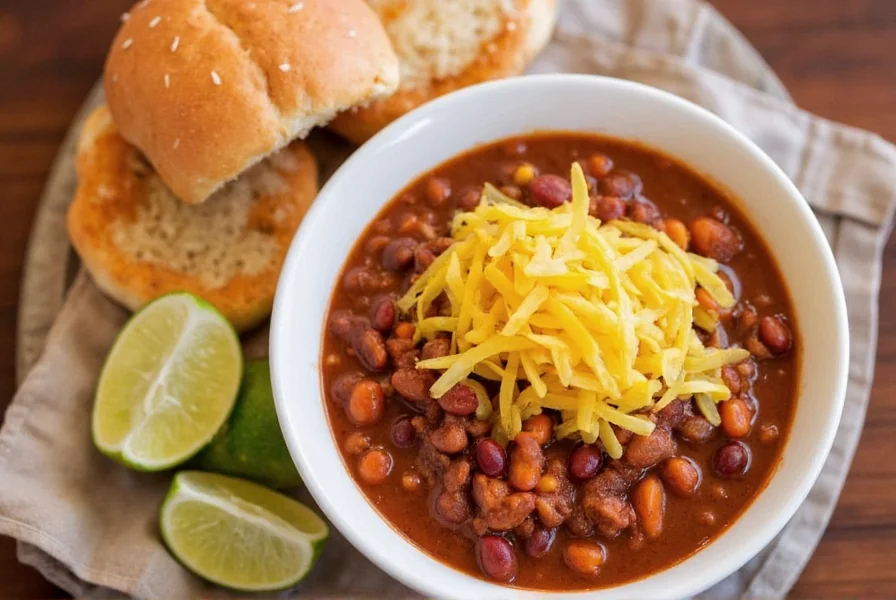Looking for the perfect chili recipe? This step-by-step guide delivers everything you need to create a flavorful, restaurant-quality dish from scratch. We've combined expert techniques with practical tips to help you master chili making, whether you're a beginner or a seasoned cook.

Easy Chili Recipe: Step-by-Step Guide
Ingredients
- 1 lb ground beef (or plant-based alternative)
- 1 large onion, diced
- 3 cloves garlic, minced
- 1 can (15 oz) kidney beans, drained and rinsed
- 1 can (15 oz) black beans, drained and rinsed
- 1 can (28 oz) crushed tomatoes
- 2 tbsp chili powder
- 1 tsp ground cumin
- 1 tsp smoked paprika
- 1/2 tsp cinnamon
- 1/4 cup strong brewed coffee
- 1 tbsp apple cider vinegar
- 1 oz dark chocolate (70% or higher), chopped
- 1 tsp salt (adjust to taste)
- Optional toppings: shredded cheese, sour cream, cilantro, avocado
Instructions
- Prepare ingredients: Dice onion, mince garlic, drain and rinse beans, and chop chocolate.
- Sear meat: In a large pot over medium-high heat, brown ground beef until fully cooked. Drain excess fat.
- Toast spices: Add chili powder, cumin, and smoked paprika to the pot. Stir constantly for 1 minute to release aromas.
- Saute aromatics: Add onion and garlic. Cook until softened (5 minutes).
- Add liquids: Pour in crushed tomatoes, coffee, and apple cider vinegar. Stir well.
- Simmer: Bring to a boil, then reduce heat to low. Cover and simmer for 30 minutes.
- Final touches: Stir in beans, chocolate, and salt. Simmer uncovered for 15 more minutes until thickened.
- Serve: Ladle into bowls and top with your favorite toppings.
| Spice | Storage Method | Shelf Life | Tips |
|---|---|---|---|
| Chili Powder | Airtight container, cool dark place | 6–12 months | Buy in smaller quantities if used infrequently. |
| Ground Cumin | Glass jar away from heat | 6 months | Toasted before use = more flavor. |
| Paprika | Dark cupboard, sealed tightly | 1 year | Heat degrades color and flavor quickly. |
| Ancho Chili Flakes | Vacuum-sealed bag or mason jar | 8–10 months | Add toward end of cooking for fresher bite. |

Expert Ingredient Selection Guide
1. Ground Chilies & Chili Powders
- Best for: Deep, earthy flavor without too much heat
- Popular varieties: Ancho, New Mexico, Chipotle
- What to look for: Freshness date, no additives, vibrant color
- Recommended brand: Frontier Co-op Organic Chili Powder – great quality, ethical sourcing
2. Fresh Chilies
- Best for: Bold, bright flavors and varying heat levels
- Popular varieties: Jalapeño, Serrano, Habanero
- What to look for: Firm skin, no soft spots, consistent color
- How to use: Roast, dice, or blend into sauces
3. Canned Beans
- Best for: Protein-rich texture and body in chili
- Popular varieties: Kidney, pinto, black beans
- What to look for: Low sodium options, BPA-free cans
- Pro tip: Rinse thoroughly before use to reduce gas-causing compounds
Frequently Asked Questions
How can I reduce chili heat without changing the flavor?
Add natural sweeteners like honey or maple syrup (1 tsp at a time), or incorporate dairy like sour cream. For deeper flavor balance, stir in 1-2 tbsp of apple cider vinegar or lime juice – this cuts heat while enhancing other notes without making it sweet.
Can I make chili completely meat-free while keeping it hearty?
Absolutely! Use a combination of lentils, portobello mushrooms, and walnuts for texture. For umami depth, add 1 tbsp soy sauce or 2 tsp smoked paprika. Our top hack: rehydrate dried porcini mushrooms in hot water, then chop finely and add both mushrooms and soaking liquid to the pot.
Why does coffee work in chili recipes?
Coffee's natural bitterness and roasted notes complement chili's earthy spices. It doesn't make chili taste like coffee – instead, it enhances smoky flavors and balances sweetness. Use cold brew concentrate (2-3 tbsp) for smooth integration without acidity, or strong brewed coffee added during simmering.

Why This Recipe Works
This chili recipe combines proven techniques from professional chefs and home cooks alike. The secret lies in the layering of flavors: toasting spices releases their oils, coffee adds depth without coffee taste, and chocolate creates a rich finish. Following these steps ensures consistent results every time.
With this recipe, you'll have a flavorful, satisfying dish ready in under an hour. Perfect for weeknight dinners or game day gatherings. Don't forget to store leftovers properly – chili tastes even better the next day as flavors meld together!











 浙公网安备
33010002000092号
浙公网安备
33010002000092号 浙B2-20120091-4
浙B2-20120091-4